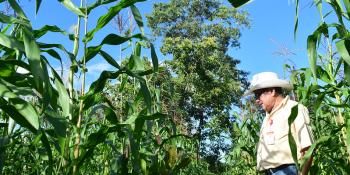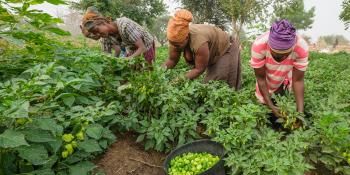Scenario guided development of Costa Rica's Intended Nationally Determined Contribution

Climate change experts met to test sectorial strategies in possible future scenarios.
CCAFS scenarios workshop "a breakthrough", according to Franklin Panigua, methodological advisor of the Ministry of Environment and Energy (MINAE) INDC Coordination team, lead by Pascal Girot.
We had to deal with a lot of resistance (from the government) to have an open dialogue with sectors that didn´t support their plans. The scenarios workshop showed that we could have a fruitful and productive discussion about how to reduce emissions. People are not there to get you, they are there to move the country forward. That moment was critical." (Franklin Panigua, consultant MINAE/UNDP)
Beginning July, with only 3 months left to define the Intended Nationally Determined Contribution (INDC), Pascal Girot´s team found itself in a difficult situation. The official data on current emissions and projections of future emissions under certain scenarios were not ready yet. Under usual circumstances, this data is used to start a dialogue and further define strategies.
We didn´t have the data, how could we decide how to reduce emissions? What we needed was to focus those [national dialogue] workshops on policy discussions, not on data. It´s about narratives, about visions in policies. That´s when Pascal had the idea to work with Universidad para la Cooperación Internacional (UCI) and the CGIAR Research Program on Climate Change, Agriculture and Food Security (CCAFS) scenarios methodology." (Franklin Panigua, consultant MINAE/UNDP)
What did we do in the CCAFS scenario workshop?
Download the policy brief: Shifting the paradigm: Narratives of the future guide the development of Costa Rica's INDC
25 national experts and decision makers in climate change and all sectors involved in reducing emissions (agriculture, transport, forests, electric energy and waste) came together to revise a summary document of current strategies taken into account to reduce emissions that MINAE had put together for the workshop. Participants from each sector first added new strategies for each sector to the document and suggested changes to current ones. They then created 4 future scenarios up to 2030 of Costa Rica under climate change that discuss matters relevant to emission reduction in the five sectors (eg consumer patterns, ways of mobilizations, production and demand of food and livestock, ect)[1]. They then tested all new and improved reduction strategies in all 4 scenarios to see which of them would be effective in each scenario and what changes would have to be made to implement them under those circumstances. This resulted in a set of robust strategies for every sector.
What happened after workshop?
After the CCAFS scenario workshop, 5 sector workshops were organized in which emission reduction strategies would be further discussed with a larger group of stakeholders from each sector. All workshops started with a presentation in which the government presented its current plans, policies and projections to reduce emissions, complemented with the new and scenario-tested strategies that had been proposed in the scenarios workshop.
Apart from giving MINAE a "shopping list of robust ideas to reduce emissions", the scenario guided process gave other far fetching results that would define future emission reduction strategies:
It showed us the preconditions that are needed to create a country in which emissions can be reduced and the collateral effects of an action to reduce emissions in one sector (such as an electric train) on other sectors (healthier citizens, better functioning cities). Participants were able to come up with these elements because they created visions of the big picture of climate change, not only about reducing emissions in one sector or the other. (..)
In terms of agriculture and livestock, the development of multiple scenarios of Costa Rica under climate change made possible the following:
- Testing and improving the effectiveness of strategies to reduce emissions in each of the scenarios
- The multisector, multistakeholder and multilevel approach and the inclusion of socio-economic, environmental and political aspects of development made it possible for stakeholders to visualize the collateral effects and necessary links between emission reduction strategies in agriculture, waste, energy and transport. Visualizing the possible obstructions to get there was especially helpful.
- The positive scenario for Costa Rica under climate change showed a clear pathway of development and necessary preconditions along the timeline in order to maximize emission reduction in agriculture; Negative scenarios highlighted other necessary preconditions such as; the property rights to water and other natural resources, the importance of a solid government and policy framework and national scientific capacities to adapt agriculture to climate changes that mitigate at the same time.
An important vacuum that still remains to be filled, and for which the entire INDC development process has not been able to find an answer, is how to address food security while reducing emissions in agriculture[2]. Taking into account Costa Rica's focus on agroexport of coffee, bananas and pineapple, current LED strategies are mainly focused on cashcrops, whereas not a lot of thought has been set to small scale producers and their subsistence farming. The support of research institutions such as CCAFS will play an important role in the nearby future.
Example of priorisation of emission reduction strategies in the energy sector and how the scenario methodology can move forward political dialogue:
Costa Rica has a long history of investments in the generation of hydroelectric energy. Although generación termica and other sources of renewable energy generation are taken into account, both in policies[3] as well as discourse MINAE shows a strong preference for investment of the same energy hydroelectric source[4], despite fierce opposition from both environmental, indigenous, farmer and civil society organizations.
The CCAFS scenario workshop showed that "an electric energy matrix dominated by mega hydroelectric and geothermic projects" was the strategy tested as least effective to generate renewable energy in three of the four future scenarios, either due to a lack of water resources or an unprofitable energy generation due to privately owned water sources. According to the INDC coordination team this has been an important ¨proof¨ to show that the government should strongly consider alternatives for renewable energy generation. This recommendation was taken forward in the sector workshop for electric energy. The final memoire of the national dialogue process to define Costa Rica´s INDC mentions that Costa Rica "should consider new political and social complexities of hydropower. It should also strengthen in the definition of the energy matrix by diversification of sources." [5]
Video of the workshop
Download the Policy Brief Shifting the paradigm: Narratives of the future guide the development of Costa Rica's INDC
[1] These scenarios were based on the CCAFS scenarios of agriculture, food security, environments and livelihoods in Central America in 2050.
[2] Taken from interview with Franklin Paniagua, nov 4th 2015.
[3] Plan Nacional de Energia 2015 - 2030
[4] Costa Rica´s electricity is provided by the state owned Instituto Costarricense de Electricidad (ICE)
[5] ¨Hay que considerar las nuevas complejidades político-sociales hidroeléctricas. También, se debe potenciar en la definición de la matriz energética una diversificación de fuentes¨ (pagina 1, ¨ Síntesis de las principales manifestaciones derivadas de los Talleres de Diálogo Sectorial sobre Metas de Reducción de Emisiones¨).
Marieke Veeger is Coordinator of the CCAFS Scenarios Program in Latin America and works for Universidad para la Cooperación Internacional (UCI), based in Costa Rica.


